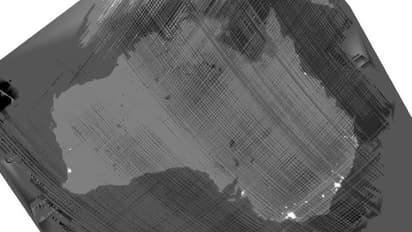'Looks like Australia': Elon Musk shares intriguing image of Earth in radio frequency, sets Internet abuzz

Synopsis
SpaceX CEO Elon Musk has shared a never-before-seen picture of planet Earth. The image, posted on his platform X, shows a unique visual of Earth in radio frequency.
SpaceX CEO Elon Musk has once again captured the world's attention with a groundbreaking glimpse of our planet. In a recent post on his platform X, Musk shared a mesmerizing image showcasing Earth as seen through the lens of radio frequency, courtesy of the Starlink satellite constellation.
The image, described as a captivating tapestry of black and grey lines adorned with scattered white spots, offers a unique perspective on our familiar world. Musk's caption accompanying the photo reads, "What Earth looks like in radio frequency from the @Starlink direct to phone satellites," igniting a wave of intrigue and admiration across the internet.
Reactions poured in from around the globe, with users expressing awe and fascination at the intricate pattern revealed by the radio frequency view of Earth. Some likened the image to the weave of fabric, highlighting the intricate interplay of signals traversing the planet's surface.
"Like clothing fabric, many threads are interwoven together," remarked one user, encapsulating the complexity of the radio frequency landscape.
Others marveled at the interconnectedness depicted in the image, likening it to a bustling network of communication.
"A bunch of nobodys communicating back and forth," quipped another user, capturing the essence of the dynamic exchange occurring across the globe.
The image drew admiration for its revealing portrayal of Earth's urban centers, which appeared as vibrant hubs of activity amidst the sea of radio signals. Observers noted how the heightened signal strength in urban areas unveiled intricate weather patterns and natural phenomena, offering new insights into our planet's dynamics.
"Observing Earth through Starlink satellites in radio frequencies reveals a view distinct from visible light. Urban areas exhibit stronger signals, unveiling weather patterns and natural phenomena," one comment reflected, emphasizing the unique perspective offered by radio frequency imaging.
Amidst the chorus of reactions, many users drew parallels between the image and the familiar contours of the Australian continent, noting striking resemblances in the radio frequency depiction of Earth. Some users argued that the image looks more like Africa than Australia.
Starlink, the satellite internet constellation spearheaded by SpaceX, has emerged as a transformative force in global connectivity. With a mission to provide high-speed internet access to underserved and remote regions worldwide, Starlink has deployed thousands of small satellites into low Earth orbit, forming a vast network that delivers internet signals to users across the globe.
Utilizing advanced technology and innovative infrastructure, Starlink leverages its constellation of satellites to establish communication links with ground stations and user terminals, enabling seamless internet connectivity in even the most remote corners of the planet.
The service, which has already been rolled out in select regions, continues to expand its coverage area with each successive satellite launch. Reports indicate that Starlink is on track to receive its initial approvals to operate in India, marking a significant milestone in its mission to bridge the digital divide and connect communities worldwide.
Check the Breaking News Today and Latest News from across India and around the world. Stay updated with the latest World News and global developments from politics to economy and current affairs. Get in-depth coverage of China News, Europe News, Pakistan News, and South Asia News, along with top headlines from the UK and US. Follow expert analysis, international trends, and breaking updates from around the globe. Download the Asianet News Official App from the Android Play Store and iPhone App Store for accurate and timely news updates anytime, anywhere.